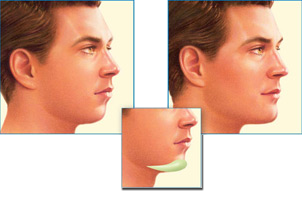If You’re Considering Facial Implants
Plastic surgeons use facial implants to improve and enhance facial contours. These implants can bring the face into balance by building up the chin, the cheeks, or the jaw. There are many facial implants available, manufactured from a variety of materials. They can help strengthen a jawline or bring the chin or cheekbones into balance with the rest of the face.
This web page describes some of the facial implants currently available as well as the techniques for their use. It will familiarize you with these procedures but cannot provide all the details which may be relevant to your particular needs.
If you feel that one or more of the procedures described here may benefit you, be sure to ask your plastic surgeon for more information.
What to Expect From a Facial Implant
Facial implants can enhance your appearance and bolster your self esteem. If you are looking for improvement, not perfection, in your appearance and are realistic in your expectations, you may find that a facial implant is the right choice for you.
Plastic surgeons will frequently use such implants to bring better balance to the features of a younger patient. For instance, a teenage girl may want her nose reshaped or her chin brought forward so that these traits are better proportioned. The more mature patient may choose to have an implant placed in conjunction with another cosmetic procedure. For example, during a facelift, a patient may wish to have implants placed over the cheekbones to help restore a more youthful appearance. Implants may also be selected to fill out a face that appears “sunken” or tired.
Cheek Surgery
To augment the cheek area, your plastic surgeon can insert cheek implants through an incision in the mouth, placing them directly on (or even below) the cheekbone. These facial implants can vary in size and shape, to achieve an individualized result.
Cheek augmentation surgery usually requires about 30 to 45 minutes. When cheek implants are being placed in conjunction with another cosmetic procedure, such as a facelift, brow lift or eyelid surgery, the implants may be inserted through the incisions made for those procedures. Otherwise, an incision will be made either inside your upper lip or your lower eyelid. Your plastic surgeon forms a pocket for the implant, inserts it and secures it into place.

Recovering from Cheek Surgery
After the surgery, a dressing will be applied to minimize discomfort and swelling. The severity and duration of such side effects may vary, especially if another cosmetic procedure was performed at the same time. Your plastic surgeon will provide you with instructions about post-operative care. There will be dietary restrictions as well as limitations to your activities. Again, these instructions will vary, especially if another procedure was performed along with your implant surgery. However, you should be aware that your ability to move your mouth and lips may be diminished temporarily. Stitches used to close the incisions inside your mouth usually dissolve within about 10 days.

Chin Surgery
Chin surgery (often called mentoplasty or genioplasty), is a surgical procedure to reshape the chin. This can be accomplished in several ways. Your plastic surgeon may recommend enhancement with a facial implant or surgical reshaping of the chin bone.
The general goal of cosmetic chin surgery is to provide a harmonious balance to your chin and facial features so that you feel better about the way you look.
Many times a plastic surgeon may recommend chin surgery to a patient having nose surgery in order to achieve facial proportion, as the size of the chin may magnify or minimize the perceived size of the nose.
With a short incision under the chin or inside the mouth, your plastic surgeon can place a chin implant directly on the bone.
Insertion of a chin implant may take anywhere from 30 minutes to one hour. Before the surgery, your plastic surgeon selects the proper size and shape implant to enhance your appearance. He or she then inserts it into a pocket over the front of the jawbone. The small incision to create the pocket and insert the implant is placed inside the mouth (along the lower lip) or in the skin just under the chin area.
Recovering from Chin Surgery
After chin augmentation, the chin is taped to minimize swelling and discomfort. Sutures in the skin will be removed in five to seven days. If an intra-oral incision is used, the sutures will dissolve.
Lower-Jaw Surgery
Jaw implants increase the width of the lower third of your face. Much like the chin, a weak jaw can be thought of as one that is not well-defined and distinct from the neck, or one that slopes rather than angles from the ear to the chin. In some cases, both the chin and jaw can contribute to facial imbalance.
Insertion of a jaw implant usually takes about one to two hours. Internal incisions are made on either side of the lower lip to provide access for creating a pocket into which the lower-jaw implant can be inserted. Dissolving sutures are used to close the incisions.

Recovering from Jaw Surgery
Swelling is sometimes significant immediately following surgery, usually peaking 24 to 48 hours afterward. Although most of the significant swelling will subside over a period of several days, prolonged mild swelling may prevent your final facial contour from becoming apparent for several months.
During the healing phase, your activities and diet will be restricted. Your ability to smile, talk or move your mouth in any way may be limited for several days to weeks following surgery. Your plastic surgeon will instruct you about dental and oral hygiene during your recovery.
All Surgery Carries Some Uncertainty and Risk
Facial implants can produce some remarkable changes. Problems rarely occur, but you need to be informed about such possibilities. This brochure will touch upon a few, but is not intended to provide a detailed or complete inventory of potential risks.
A facial implant can shift slightly out of alignment and a second operation my be necessary to replace it in its proper position. Infection can occur with any operation. If infection were to occur around a facial implant and did not clear up after treatment with antibiotics, the implant might have to be temporarily removed and replaced at a later time. Other, less-frequent risks may be associated with certain implants. Be sure to ask your plastic surgeon for a description of the risks associated with the procedure in which you are interested.
Some of the implant materials are made of a solid silicone. Currently, there is no scientific evidence that this is a harmful substance. Your plastic surgeon will be happy to discuss any current scientific findings concerning the type of implant you’re considering.
Planning Your Surgery
When you discuss your surgery with your plastic surgeon, be certain that you clearly express your expectations. Your plastic surgeon will help you determine what it is possible to achieve. It may be helpful to provide your surgeon with photos of people who have facial features similar to those you would like to have.
Be sure you understand the details of the proposed surgery, including the cost and what to expect during your recovery.
If the surgery will entail an incision inside your mouth, it is important that you inform your physician if you smoke or if you have any dental or gum problems. Your plastic surgeon will advise you on these matters.
In preparing for your surgery, be sure to find out if you’ll be able to drive home afterward or will require transportation. You should also ask if you’ll need to refrain from eating or drinking the night before your surgery, and if you should stop taking any medications, including aspirin and similar drugs. You may be instructed to take oral antibiotics both before and after the procedure to help guard against infection.
Your plastic surgeon will provide information about these important matters during your pre-operative consultation.
Where Your Surgery Will Be Performed
Your operation may take place in an office-based facility, a freestanding surgical center or a hospital outpatient facility. Sometimes, your plastic surgeon may require that you stay overnight. Your doctor will make such a recommendation based on your overall medical condition and whether another cosmetic procedure was performed simultaneously with the facial implant surgery.
Types of Anesthesia
In some cases, facial implant surgery may require only local anesthesia combined with a sedative. However, more frequently, a general anesthesia may be recommended.
Your New Look
Remember, with any facial surgery, you may feel and look better in a short period of time. However, it may not be advisable to participate in certain activities (especially activity that may result in the face being jarred or bumped) for several weeks. It’s best to check with your plastic surgeon about such matters.
You may not be able to accurately evaluate your appearance for weeks, or perhaps even months. Give yourself plenty of time to get used to your new look.
You may be surprised to find that most people won’t recognize that you’ve had facial implant surgery only that you look better.
